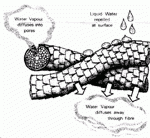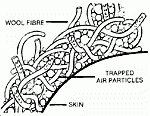Wool Fibres
Qualities of Wool
Wool ‘Breathes'
Under a microscope a wool fibre is seen to be covered by a thin sheath of overlapping scales that act rather like tiny roof tiles. The scales cause liquid water to form beads and roll off. This enables a wool fabric to repel moderate rain and spills.
In contrast, wool absorbs water vapour (from the air or from perspiration), through the porous coating over the scales. Hence wool can absorb up to 30% of its own weight in moisture-without feeling clammy. Damp wool fabric remains absorbent and comfortable inside because its outer surface releases this moisture through evaporation.
Wool fibres strive to stay in balance with the surrounding moisture conditions-this is why wool is said to breathe as it absorbs and evaporates moisture.
Wool generates heat
When moisture enters the fibre (for example, when we go outside on a cold, damp day), a significant amount of energy is released. This enables a wool jersey or other garment to provide a warming effect while the moisture is being absorbed. Every kilogram of wool generates about as much energy as the human body metabolism produces in one hour. And when you return to a dry, warm indoor environment, the moisture is released and a cooling effect is the result.
Wool the insulator
Wool also provides us with warmth through its insulation properties. In a wool garment the crimp in the fibres makes them stand apart from each other. As a result, little pockets of still air are trapped between the fibres. This lining of air trapped inside the fabric acts as an insulator (as well as the layer between the fabric and the skin).
Information, courtesy of:


